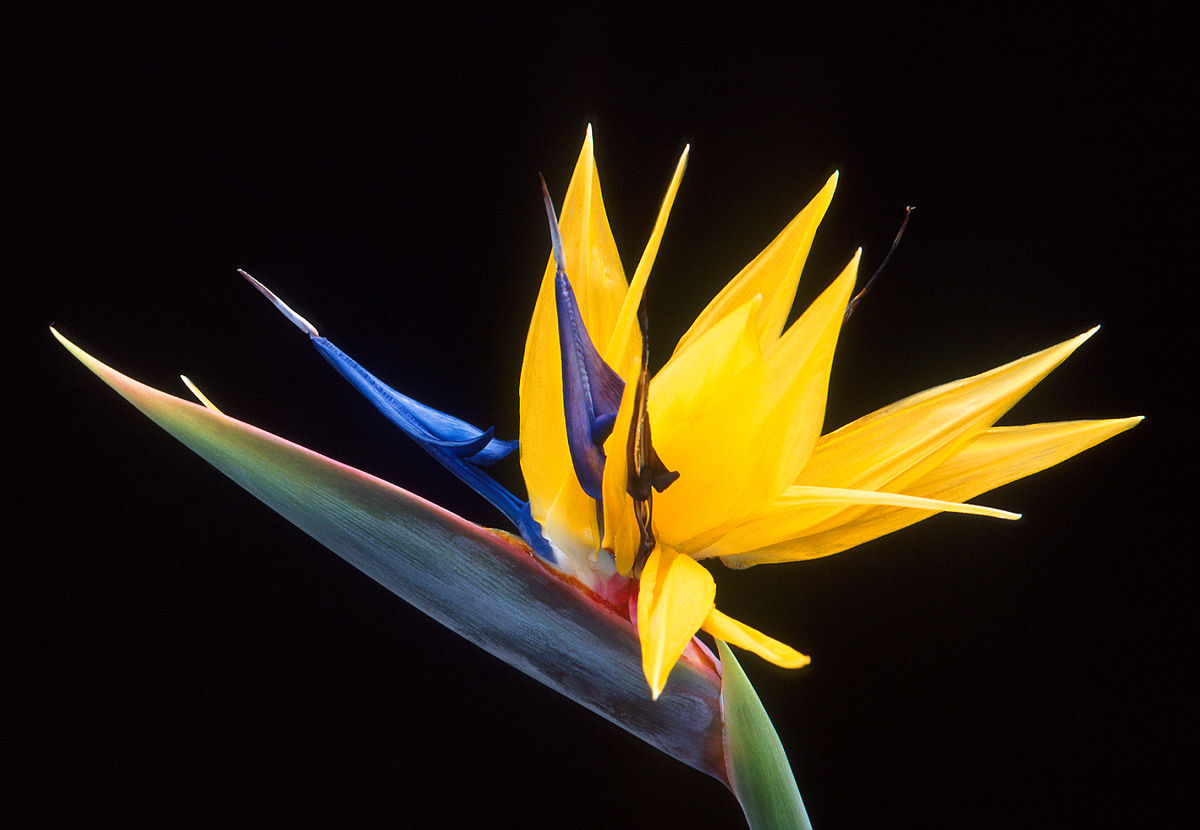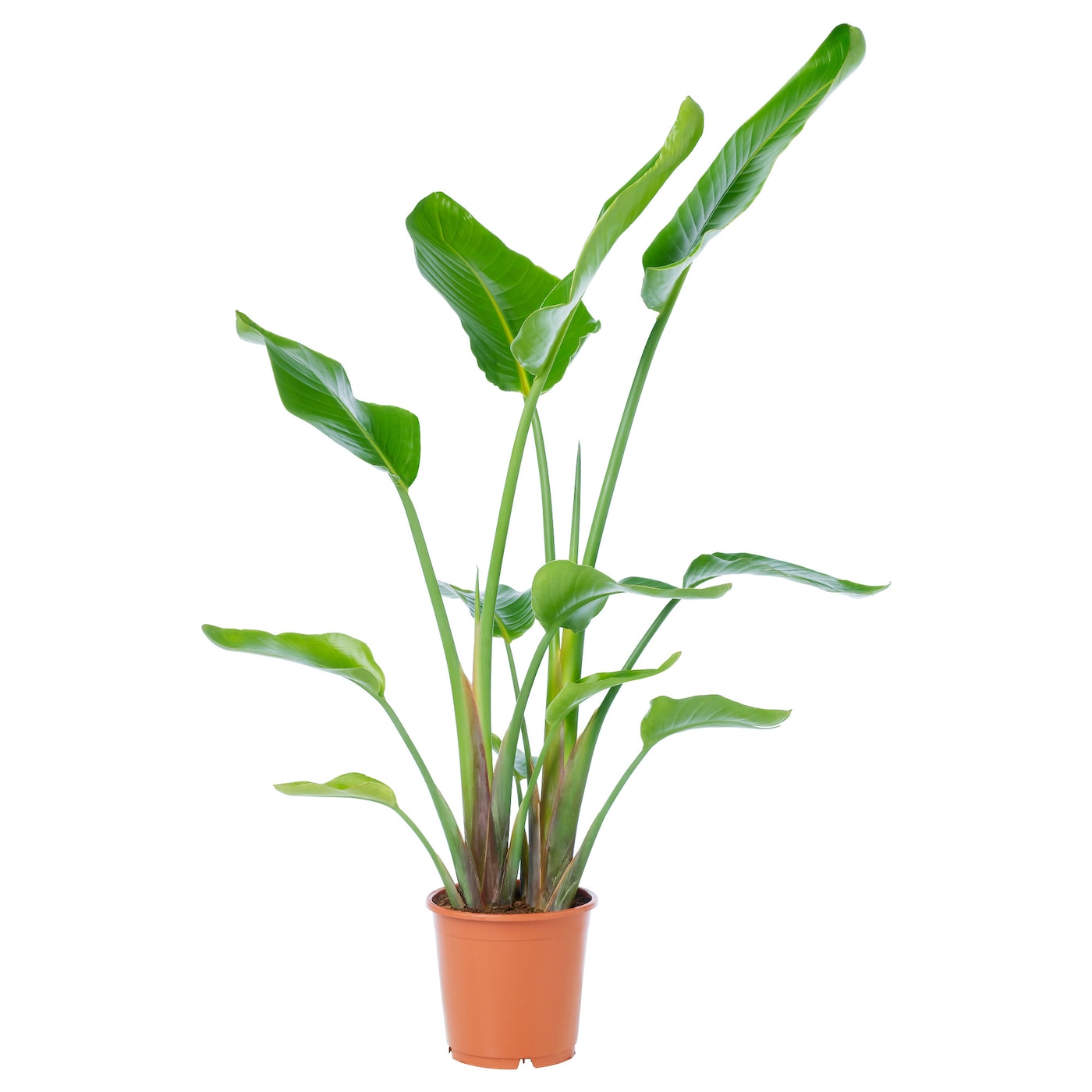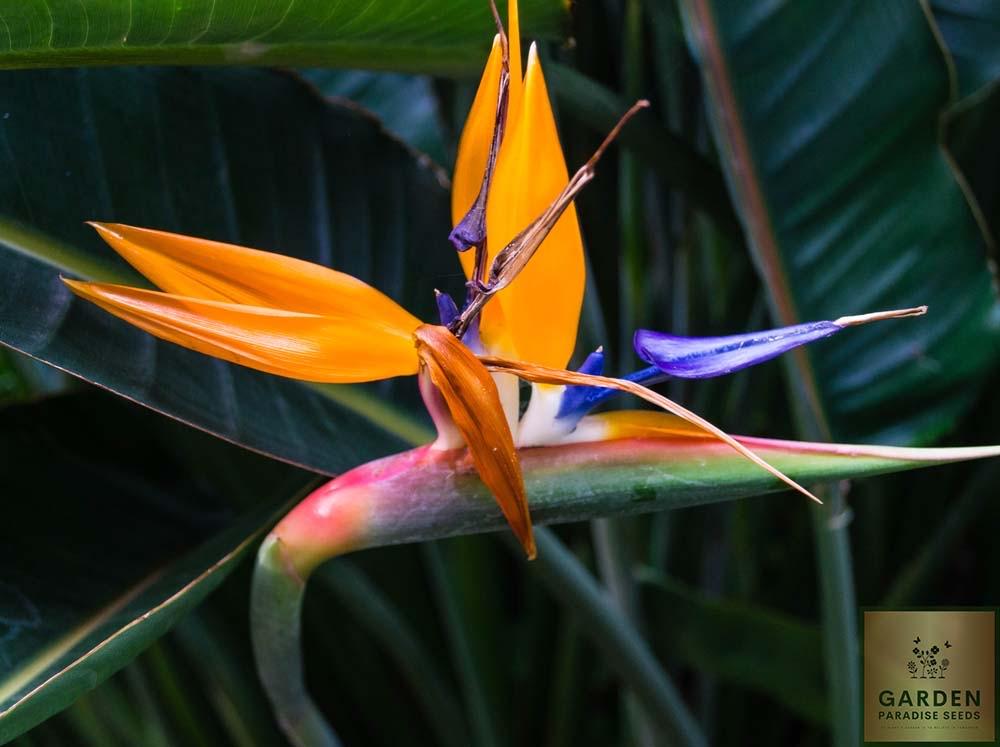
For many, the Strelitzia is one of the most desirable houseplants. After a single glance at this plant, it becomes clear why: its beautiful leaves are large and impressive. With the Strelitzia you have a very large, yet graceful plant in your home. In addition, a big advantage is that it can stand in full sun. Something many other houseplants cannot. You can read more about its care on this page. If you take good care of your Strelitzia, it will last for years.
Table of Contents
Strelitzia care
Watering the Strelitzia
Watering is an important part of caring for the Strelitzia, but how much water do you give? It is important to match the amount of water to the consumption of the plant. You’re going to find that the Strelitzia uses more water in the summer than in the winter. Also, a large plant consumes more water than a small one.
In the beginning, it is good to feel the soil to see if there is a need for water. Is the soil still wet? Then wait a while before watering. Is the soil dry? Then you can water. After a while you will discover a routine and you will not need to constantly check the soil.
You can also tell by the plant’s appearance if you are giving it too much or too little water. You see a shortage of water quickly enough: The Strelitzia hangs limply. So if your plant starts drooping, you know it’s time to water it. Too much water is often reflected in black spots on the stem (the first sign that mold is forming). A yellow leaf is also a sign of too much water. More on preventing this further down this page.
Watering
A Strelitzia in the wild occurs in places where the humidity is very high. The difference with our living room is huge! To reduce this difference it is wise to spray the leaves with a plant sprayer. You can do this with normal tap water, preferably several times a week.
Watering the Strelitzia also has other advantages. Because the leaves are made wet several times a week, dust is less likely to settle on them. Less dust on the leaves naturally means a more beautiful plant, but it also means that the leaves can better perform their function: photosynthesis. An additional advantage is that insects, such as aphids, are less likely to settle on a plant that is regularly moistened.
Strelitzia location and light
When choosing a location, make sure that the Strelitzia gets as much sun as possible. Direct sunlight is very important for the beautiful and healthy growth of this plant. So a dark place is definitely not suitable. If you know this, you will notice: Almost everyone who has a Strelitzia puts it near a window. That’s perfect, preferably even a south-facing window.
The bathroom may be a suitable place because of the high humidity, but unfortunately most bathrooms don’t have the right amount of sunlight that the Strelitzia needs. The living room is often a better option then anyway.
Over time, the plant may start to grow crooked. You’ll notice that the leaves are all pointing in the same direction, which means the plant will start to lean. You can turn the Strelitzia a quarter turn to make it grow upright again.
The right temperature
We wrote earlier that these plants originate from tropical areas. Yet the Strelitzia survives just fine at normal room temperature. The best is when it never goes below 16 ℃. This can sometimes happen if a window is open (in winter) or if the plant is next to the air conditioner (in summer). Try to avoid these situations.
A misconception is that this plant can be close to a radiator. After all, high temperatures would be good, right? The warm air coming from a radiator is really too hot, but mainly: too dry. This very dry air causes all sorts of problems for the Strelitzia that should be avoided.
Pot and repot
Every two years repotting of the Strelitzia is necessary because this plant can grow very fast. As the plant uses up all the space in the pot, there is less room to store water. A Strelitzia that often hangs limply is one of the first signs that the plant needs a larger pot.
Repotting is best done in the spring. That way, the Strelitzia still has time to recover from the operation. Choose a flower pot that is at least 20% larger than the previous one. It is also very important to ensure good drainage. You can do this by drilling holes in the bottom of the pot and adding a layer of hydro grains to the bottom of the pot. If you do not do this, excess water cannot drain out of the pot, which will eventually kill the Strelitzia.
Which potting soil to use?
This plant is a real powerhouse. It does not really matter to the Strelitzia which potting soil it is in. A universal potting soil for (house) plants is fine. If you have the choice, it is even better to go for a potting soil based on coconut. This is more airy and gives the roots more space.
A universal potting soil is often more dense in structure. After a while, and as you have been watering more often, the potting soil will sink in further. This can cause problems for some houseplants, but as you repot the Strelitzia every two years, this will not be a problem for this plant.
Plant nutrition for the Strelitzia
This fast grower definitely needs plant food to stay beautiful and healthy. It is important not to just add anything, but to adjust the amount of plant nutrition to the needs of the plant. This means:
- After repotting, do not add nutrition for a period of time. Read on the packaging of the potting soil for how long there is nutrition in the soil. After that, you can switch to liquid plant food.
- Only add plant food when the Strelitzia is in its growth phase. Usually this is during spring and summer.
- Always read the instructions on the package. Never give more than indicated. Excess nutrition in the pot can cause serious damage to the roots of the Strelitzia.
Strelitzia species
Did you know that the name of the plant is a reference to the wife of English King George III: Charlotte of Mecklenburg-Strelitz. This name was given to the plant upon its discovery, in South Africa. There, the Strelitzia still grows in the wild. You can find 5 species there:
- Strelitzia nicolai
- Strelitzia alba (synonym: Strelitzia augusta)
- Strelitzia caudata
- Strelitzia juncea
- Strelitzia reginae (synonym: Strelitzia parvifolia)
Frequently asked questions and problems
How big can a Strelitzia get?
We know large houseplants like the Philodendron and the Monstera, but then the Strelitzia comes along. The Strelitzia can grow up to 10 feet tall in the wild. That really is a gigantic plant! Other types don’t get as big, but still easily manage a height between 2 and 6 feet. At these sizes, the leaves can grow up to 2 meters long and 80 centimeters wide. At this height, it is quite possible that the plant will start to droop. In that case, tying it up is an option.
You can buy the Strelitzia small, but fortunately also quite large. So you do not have to wait long to have a plant of 2 meters high. Often this plant is sold with a height of 160, 180 or 200 centimeters.
How fast does a Strelitzia grow?
A Strelitzia grows very quickly, especially in spring and summer. It is quite possible that you will see a new leaf appear every week. During its rapid growth you must support the Strelitzia with sufficient water and nutrition. During the growth phase, make sure that the soil never dries out completely and give a little food every week.
Can you take cuttings from this plant?
You certainly can! See the page about Strelitzia cuttings.

It is a strong plant and therefore it can take a beating. It can also withstand critters and diseases for a while, but it is meant to be taken care of eventually. Because of its high growth rate, this plant is susceptible to aphids (both aphids and scale insects) and spider mites. In addition to treating critters, it is good to prevent them. To do this, spray the leaves several times a week. It also helps to keep the plant healthy: that way it is more resilient. Prefer a houseplant that is less susceptible? Then take a look at the Peperomia.
New leaves do not roll out
You may recognize the growth habit of the Strelitzia from other tropical plants such as the Calathea: a new leaf appears rolled up in the middle and then rolls out. With very rapid growth it can happen that a new leaf does not roll out. In that case, you can spray the rolled up leaf daily with a plant sprayer. This will cause the leaf to soak loose, as it were, and eventually open. Don’t be alarmed if the leaf never assumes the dimensions of the leaves before it, then the rolling out simply took too long. The next leaves will be just as big (or bigger) again.
White mold on the potting soil
If the soil is moist for a long time you may see white mold appearing on the potting soil. You can remedy this by removing the top layer of soil. Do this in time, otherwise you may get mourning flies. If you have removed a lot of soil, you can of course add a layer of new one.
Tearing Strelitzia leaves
It’s easy to imagine that you don’t like the cracks in the leaves and would rather prevent them. Unfortunately, tearing the leaves of the Strelitzia is normal. If it is very bad you can choose to cut off a leaf.

| Botanical name | Strelitzia |
| Family | Strelitziaceae |
| Leaf color | Green |
| Maximum height wild | 10 feet |
| Maximum height houseplant | 2 feet |
| Water requirements | Keep soil slightly moist |
| Light requirements | Lots of direct sunlight |
FAQ
Can bird of paradise grow in the shade?
Give bird of paradise a spot in full sun for best growth and most flowers. The exception to that is in the hottest regions, where partial shade protects plants from strong sun and heat.
Is Strelitzia a good indoor plant?
They work well in massed plantings outside or as a specimen plant in warm climates, where their flowers rise above the foliage for an impressive display. The trick to successful growth indoors is bright light with direct sun, regular watering, and warmth.
How do you take care of Strelitzia?
Birds of Paradise enjoy moist (but not soggy) soil, and being allowed to dry out slightly between waterings. Try not to let the soil dry completely through the pot, but also avoid overwatering. Allow the top 2″ – 3″ of the soil to become dry between waterings, but below that should remain moist.
Can bird of paradise plant survive in low light?
It is relatively hardy and adapts to a wide spectrum of light conditions from direct sun to low, indirect light, but will flourish in a sunny spot. Water and humidity are important to keep your Bird of Paradise healthy.
How much sun does a Strelitzia need?
6 hours
